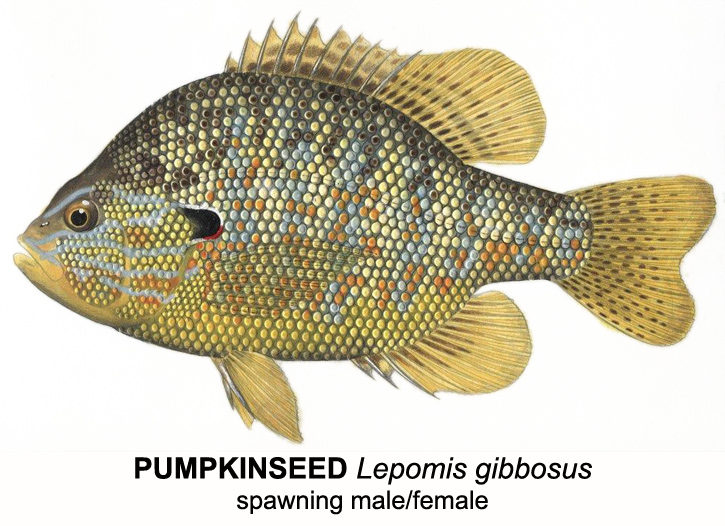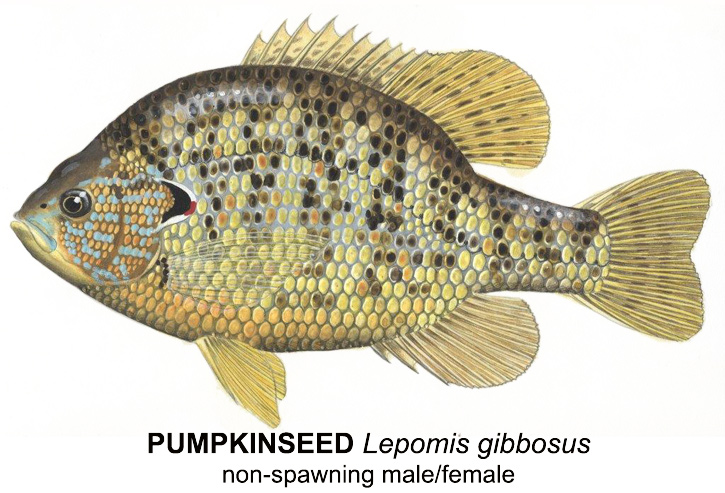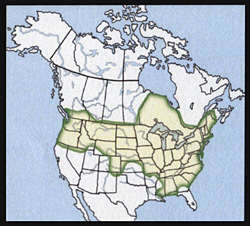Pumpkinseed, September 2014, Fish of the Month!
A Brief Note to Our Readers:
A brief note about this family of Fishes: The Sunfish family includes a large number of very North American species. We're including many of them here (in spite of their often small size) because they make excellent warm-water training species for young anglers and because adult warm-water fly-fishers are likely to often take them as incidental catches and would like to know what species they've brought to hand.

 Pumpkinseed
Pumpkinseed
Lepomis gibbosus
Local Names:
Sunny, Common sunfish, Kivvy, Kibbie, Yellowbelly, Quiver, Roach, Sunfish, Sun bass, Punky
Average Size:
7 to 8 inches
Distinguishing Field Marks:
(See the illustration.)
-
Deep almost round body, with a high rounded back.
-
The head is not large in comparison to the body.
-
The eye is large and dark colored.
There are pale aqua-blue irregular streaks on the gill covers and cheeks.
The opercular (ear) flaps are relatively short with black interiors bordered by a white outside edge with a short red mark just below the center of the flap. This red mark on the "ear-flap" is a reliable field mark to distinguish this species from the Bluegill.
The mouth is small and tipped upward. The upper jaw extends back only to the front edge of the eye.
The first dorsal fin has 10 spines and is fully attached to the second dorsal.
The tail is slightly forked with rounded lobes.
The anal fin has 3 graduated spines.
The paired pelvic fins have 1 spine and pointed tips.
The pectoral fins are large, nearly transparent, and pointed.
North American Range:
Map to the right shows approximate range in North America.
Diet:
Throughout their lives, Pumpkinseeds feed almost exclusively on immature and adult aquatic insects and other invertebrates. They often feed at or near the water's surface.
Biology:
Genus-typical winter aggregations of Pumpkinseed sunfish break up at water temperatures of about 50 degrees F. when mature males move to shallower areas, choose and defend nesting territories, and begin fin-fanning the bottom to open nests that are situated very close together.
Water temperatures in these shallow nesting areas rise quickly inducing spawning that may last from June well into August. With the completion of the nests, females will begin entering the colony and males will rush to them and commence a courtship dance which involves their swimming in circles around and over the female with which they choose to spawn. When the pairs are ready, they begin circling the nest and then the female tips her body, with the male remaining upright, and their vents touching. Small batches of eggs and milt are released and settle into the bottom of the nest. The pair then goes back to circling the nest in preparation for another spawning. This ritual may go on over the course of a day or two. Females may mate with several males and breeding pairs may also spawn over nests which are not their own. The eggs, guarded and aerated by the male parent, incubate for a period of from 3 to 5 days, and the male remains at the nest site, protecting the newly-hatched fry for a short period.
As adults, Pumpkinseeds are found in shallow rocky or weedy areas of lakes, ponds, and slower portions of some streams.
Fly Fishing for Pumpkinseed:
Now widely distributed in the United States and southern Canada, the Pumpkinseed is one of the most frequently caught members of its genus. This colorful, aggressive, hard-fighting species is very willing to take a broad range of small offerings. Wet and dry flies, and small poppers, will all entice Pumpkinseed to strike.
Fly fishing gear in the 3 to 5 weight range is best for handling these fish. As Pumpkinseeds frequently take food at the surface, occasionally gain good size, and are very strong battlers, using their deep slab-sided bodies to their best advantage when hooked, using small foam bodied poppers on a floating line is a very enjoyable sight-fishing approach to taking these rather elegant fish.
Significance to Humans:
One of the most common of our small sunfishes, the Pumpkinseed is an excellent sport fish for its size and is also a fine fish for the table. It is also another of our small sunfishes that can thrive in the habitat of a home aquarium.
Status:
Thriving throughout its broad North American range.






